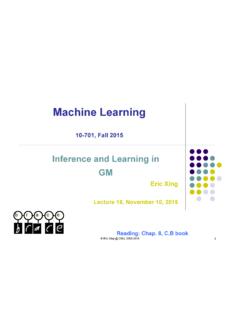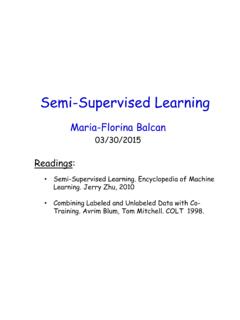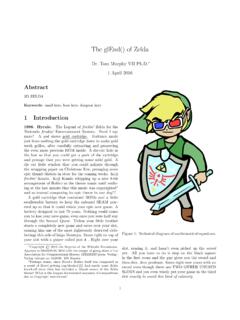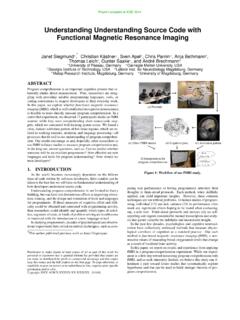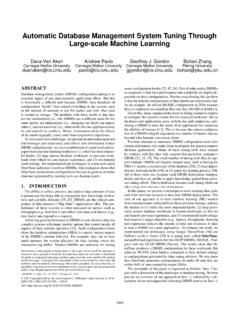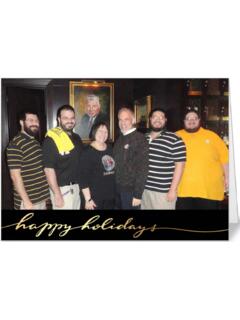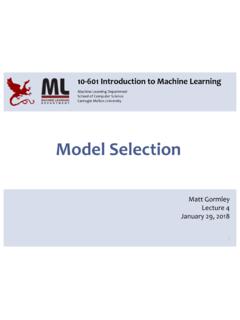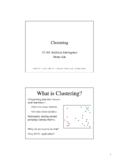Transcription of Genetic Algorithms (GAs)
1 Algorithms in Nature Genetic Algorithms History History of GAs As early as 1962, John Holland's work on adaptive systems laid the foundation for later developments. By the 1975, the publication of the book Adaptation in Natural and Artificial Systems, by Holland and his students and colleagues. History of GAs early to mid-1980s, Genetic Algorithms were being applied to a broad range of subjects. In 1992 John Koza has used Genetic algorithm to evolve programs to perform certain tasks. He called his method " Genetic programming". (GP). What is GA. A Genetic algorithm (or GA) is a search technique used in computing to find true or approximate solutions to optimization and search problems.
2 (GA)s are categorized as global search heuristics. (GA)s are a particular class of evolutionary Algorithms that use techniques inspired by evolutionary biology such as inheritance, mutation, selection, and crossover (also called recombination). What is GA. The evolution usually starts from a population of randomly generated individuals and happens in generations. In each generation, the fitness of every individual in the population is evaluated, multiple individuals are selected from the current population (based on their fitness), and modified to form a new population.
3 What is GA. The new population is used in the next iteration of the algorithm. The algorithm terminates when either a maximum number of generations has been produced, or a satisfactory fitness level has been reached for the population. No convergence rule or guarantee! Vocabulary Individual - Any possible solution Population - Group of all individuals Fitness Target function that we are optimizing (each individual has a fitness). Trait - Possible aspect (features) of an individual Genome - Collection of all chromosomes (traits) for an individual. Basic Genetic Algorithm Start with a large population of randomly generated attempted solutions to a problem Repeatedly do the following: Evaluate each of the attempted solutions (probabilistically) keep a subset of the best solutions Use these solutions to generate a new population Quit when you have a satisfactory solution (or you run out of time).
4 Example: the MAXONE problem Suppose we want to maximize the number of ones in a string of l binary digits Is it a trivial problem ? It may seem so because we know the answer in advance However, we can think of it as maximizing the number of correct answers, each encoded by 1, to l yes/no difficult questions`. 10. Example (cont). An individual is encoded (naturally) as a string of l binary digits The fitness f of a candidate solution to the MAXONE. problem is the number of ones in its Genetic code We start with a population of n random strings. Suppose that l = 10 and n = 6.
5 11. Example (initialization). We toss a fair coin 60 times and get the following initial population: s1 = 1111010101 f (s1) = 7. s2 = 0111000101 f (s2) = 5. s3 = 1110110101 f (s3) = 7. s4 = 0100010011 f (s4) = 4. s5 = 1110111101 f (s5) = 8. s6 = 0100110000 f (s6) = 3. 12. Step 1: Selection We randomly (using a biased coin) select a subset of the individuals based on their fitness: Individual i will have a f (i ). probability to be chosen f (i). i 1 Area is 2. n Proportional to fitness value 3. 4. 13. Selected set Suppose that, after performing selection, we get the following population: s1` = 1111010101 (s1).
6 S2` = 1110110101 (s3). s3` = 1110111101 (s5). s4` = 0111000101 (s2). s5` = 0100010011 (s4). s6` = 1110111101 (s5). 14. Step 2: crossover Next we mate strings for crossover. For each couple we first decide (using some pre-defined probability, for instance ) whether to actually perform the crossover or not If we decide to actually perform crossover, we randomly extract the crossover points, for instance 2 and 5. 15. Crossover result Before crossover: s1` = 1111010101 s2` = 1110110101. After crossover: s1`` = 1110110101 s2`` = 1111010101. 16. Step 3: mutations The final step is to apply random mutations: for each bit that we are to copy to the new population we allow a small probability of error (for instance ).
7 Initial strings After mutating s1`` = 1110110101 s1``` = 1110100101. s2`` = 1111010101 s2``` = 1111110100. s3`` = 1110111101 s3``` = 1110101111. s4`` = 0111000101 s4``` = 0111000101. s5`` = 0100011101 s5``` = 0100011101. s6`` = 1110110011 s6``` = 1110110001. 17. And now, iterate . In one generation, the total population fitness changed from 34 to 37, thus improved by ~9%. At this point, we go through the same process all over again, until a stopping criterion is met Introduction to Genetic Algorithms 18. Biological motivation Biological Background The cell.
8 Every animal cell is a complex of many small factories working together. The nucleus in the center of the cell. The nucleus contains the Genetic information Biological Background Chromosomes . Genetic information is stored in the chromosomes Each chromosome is built of DNA. Genes are encoded in the chromosomes Genes code for proteins Every gene has a unique position on the chromosome Biological Background: Genotype and phenotype The entire combination of genes is called genotype A genotype leads to a phenotype (eye color, height, disease predisposition). The phenotype is affected by changes to the underlying Genetic code Biological Background Reproduction.
9 Reproduction of genetical information Mitosis Meiosis Mitosis is copying the same Genetic information to new offspring: there is no exchange of information Mitosis is the normal way of growing of multicell structures, like organs. Biological Background Reproduction Meiosis is the basis of sexual reproduction After meiotic division 2 gametes appear In reproduction two gametes conjugate to a zygote which will become the new individual Crossovers leads to new genotype Mutations In any copying process errors can occur, so single (point) mutations ate pretty common.
10 Other types of errors, including affecting longer regoins (either deletion, inversions, substitutions etc.). can also occur Natural selection . The origin of species: Preservation of favourable variations and rejection of unfavourable variations.. There are more individuals born than can survive, so there is a continuous struggle for life. Individuals with an advantage have a greater chance for survive: so survival of the fittest. GA Operators Methods of representation Methods of selection Methods of Reproduction Common representation methods Binary strings.
